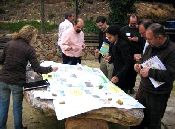|
Gully stabilisation: experimental results and conclusions |
 |
|
 |
The North West of Morocco has areas with extensive gullying of the agricultural lands. High pressure agriculture and overgrazing, combined with occasional heavy rainfall, causes severe land degradation.
An additional problem is sedimentation in the drink water reservoirs downstream. For farmers in the area, annual crops for food production and livestock for immediate income is vital. Conservation measures must improve their situation or they will not be acceptable.
|
Experiment: planting bushes to stabilise gullies
|
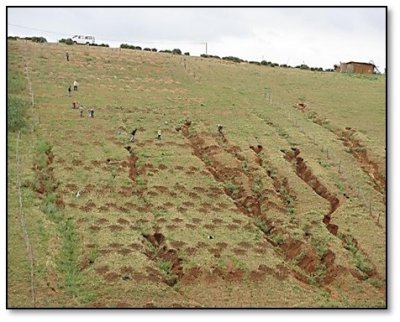 |
A good way to stabilize gullies and prevent further erosion is planting shrubs. The species must be able to survive dry years, and Atriplex halimus was chosen and planted in 2009 in a regular pattern across the gullies. Atriplex is a Mediterranean species and adapted to the climate, but initially the plants were irrigated to protect them from drought. The gully area is fenced to keep out animals. The experimental plot has been isolated for two years after which controlled grazing took place. Apart from stabilization the species can be used as a fodder, and fencing of the area is expected to cause rangeland restoration. |
This long term experiment was started in 2008 where weather conditions, biomass, soil moisture and soil properties are monitored.
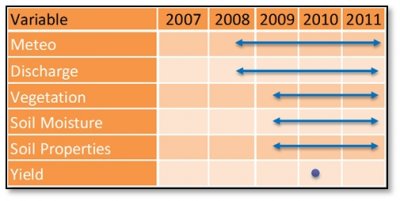 |
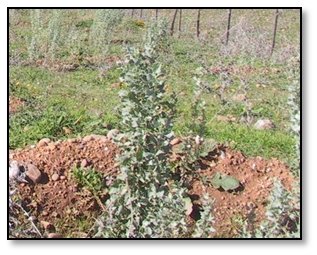
Atriplex halimus
|
The experiment has clear effects both on the biomass increase and the gully stabilisation. Biomass of both annual grasses and perennials has increased considerably from 360 kg/ha to over 1200 kg/ha. Also the quality of the vegetation has increased, with good grass species, making this a viable source of fodder. The number of grass species was 20/m² on the ‘atriplex’ plot as opposed to 10/m² on the fallow plot. Expressed in cover % the cover was more permanent (see figure below). Experience shows that in a dry year the Atriplex survives and provides a minimum biomass, while in a wet year there is a combination of grasses and Atriplex. The effect on sediment loss needs longer monitoring at catchment level, but no forther gully change has been observed in the plot.
 |
Cover % of the trhee plots: while the cover of annual grasses is about the same, the perennials give a good alround cover and protection. |
Soil moisture seems to be higher in the Atriplex plot although this may differ from season to season according to rainfall. The soil was less compacted in th plot. Effect on other factors such as soil organic matter need longer monitoring to evaluate. The establishment of this plot however also brings costs. An analysis of the costs and benefits in terms of fodder gives the following estimates. The prices are relative to currency changes.
 |
The effect of 2 years of fencing showing a decrease of the gully area (left) by gradual collapsing and filling in (marked as regression) as opposed to the reference area (right) where the gully area that has increased (marked as progression). |
 |
Input costs for installing the intervention and output benefits.
|
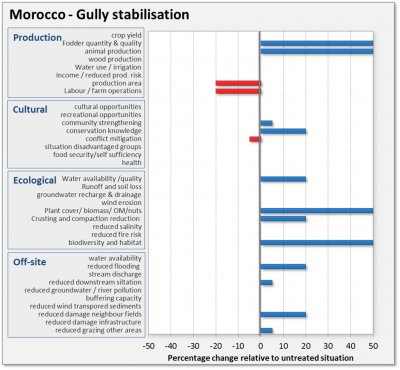 |
The results are evaluated from a production, socio-cultural and economic point of view. The bars express the estimated or measured percentage of change with respect to the reference situation. This change can be positive (blue) or negative (red). Note that this evaluation is based on the experiments, on the long term experience of the coordinating team in this area and on consultations with the farmers. |
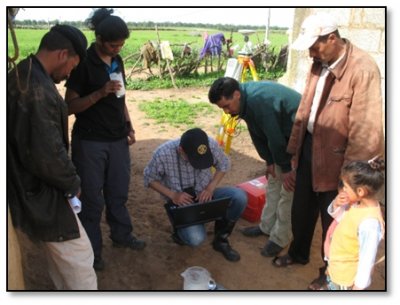 |
The results of the experiment are positively regarded. However the farmers point out that a large scale fencing and planting of the degraded lands in the region is impossible for them, without financial compensation for time and subsidized equipment and materials. An initial set aside period of 2-3 years would mean a substantial (temporary) loss of grazing land. |
The initial investments are approx. 2x as high as the combined 3 year returns in this experiment. The farmers are spectators at the moment, until the long term effects are clearer and more convincing. The general knowledge on land degradation is improving however, because of these experiments.
|
On a small scale the experiments are successful. The area is degraded in places but apparently a natural restoration seems possible when the areas are protected from grazing, at least temporarily. There are indications of a decrease in erosion while at the same time the fodder quality and quantity increases. Thus it can be beneficial for farmers. On the long run a further stabilization of the slopes is expected.
|
| This positive effect is off-set by a large initial investment in time, labour and money. This would make a large scale adaptation of this measure impossible, and fencing areas that are otherwise open for grazing may have also social and cultural implications. Also initially the area is set aside causing a decrease of grazing land of a few years. A viable approach could be to establish several of these experiments in strategic and visible locations both to combat erosion and to promote acceptance and increase understanding. |
|
A long term effect of a larger availability of fodder might be that a reduction in pressure on other ecosystems, such as the forested areas that are now overgrazed.
|
|

